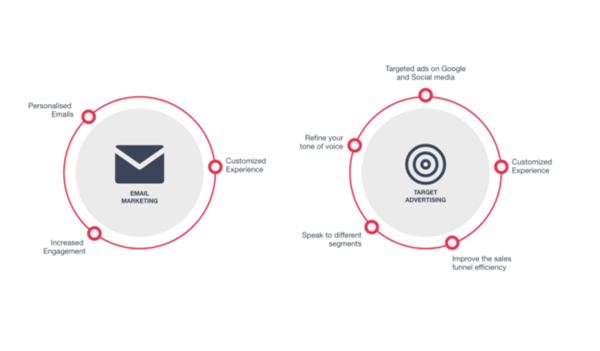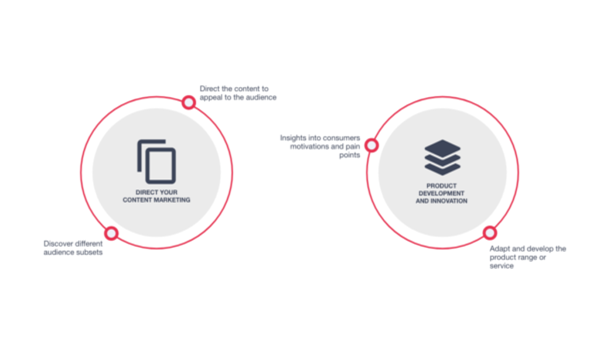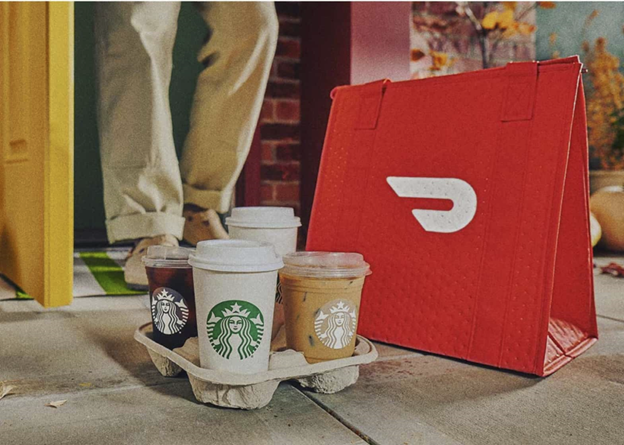Lately, psychographic segmentation gained in popularity as it delves into the intricacies of customer behaviour, preferences, lifestyle and values. The examples of psychographic segmentation from renowned brands prove its value in driving business success.
Just as access to quantitative big data revolutionised the possibilities of behavioural segmentation, developments in AI are shaping new possibilities around psychographic market segmentation.
Conducting large-scale research for psychographic segmentation was once arduous and inefficient. Thanks to advancements in AI technologies that automate the process, psychographic market segmentation is more practical and accessible than ever.
Given these new capabilities, let’s explore the psychographic market segmentation benefits, applications, how AI is changing the way it is conducted and real-life examples from famous brands.
Psychographic Market Segmentation Definition
Every single decision you make is motivated by something.
Example: What are you going to have for dinner tonight?
If you’re spontaneous, you might just pick up something on the way home and not give it much thought.
If you’re habitual, it’ll be the same thing you had last [insert day of the week here].
If you’re rationally driven, it might be something to balance what you had for lunch.
If you’re emotionally driven, you might pick up some comfort food (it’s been a tough day at work) or something that reminds you of your childhood.
Your consumer base is made up of people who are motivated by a myriad of things. Some of those things are situational, but their personality type is at the core of their decision-making.
Psychographic market segmentation is a type of marketing segmentation that aims to identify what motivates each of your customers and divide them into groups based on personality traits and the reasoning behind their decisions.
From there, you can tailor your messaging and communication style to each segment to maximise the effectiveness of your marketing campaign, product development, and customer service.

Advantages of Psychographic Market Segmentation
Target with accuracy
Optimise your marketing messaging by speaking directly to your audience using a language that resonates with them. For example, rational thinkers respond to facts and evidence, whereas emotional thinkers respond to feelings and social rewards.
Personalise chatbots and emails so customers feel they are engaging with a representative. Mass emails are perceived as spammy. The more relevant your messaging is, the more your customers will likely engage and come away with a positive perception of your brand.
Improve efficiency
Targeted messaging maximises the effect of each and every ad and email you send. Save time and money by efficiently converting leads into sales.
Build brand loyalty
If you continually and consistently send relevant messages to your customers, they’re more likely to stay connected and develop loyalty to your brand. Misjudged or unwanted messaging, conversely, can negatively impact brand loyalty.
Connect with a more diverse audience
Segmentation enables you to market to a more diverse group without fundamentally changing your product or service. Approach your product from all angles and market to a new set of customers with different needs and motivations from your primary customer base.
Applications of Psychographic Market Segmentation

Email marketing
Create personalised emails that belong in your customers’ inboxes. Increase engagement by aligning your messaging with different personalities. Create a customised experience by directing customers to different landing pages depending on their psychographic profile.
Targeted advertising
Create targeted ad campaigns on Google and social media channels. You can’t filter your ads by psychological traits (give it time), but you can make associations between behaviour and psychographics.
For example, use likes, interests, and psychological traits to refine your tone, speak directly to different segments, and improve the efficiency of your sales funnel.

Manage your content marketing
Discover the different subsets of your audience and direct your content to appeal to them. Use your findings to enhance your product descriptions, blog, and social media content.
Product development and innovation
Gain deeper insight into consumers’ motivations and pain points and use that information to adapt and develop your product range or service.
Emerging Technologies vs Traditional Methods
Until recently, conducting psychographic segmentation research has been time-consuming and costly.
Surveys, interviews, and focus groups are all great ways of understanding your customers in-depth, but there are several issues with these traditional methods.
- There’s no guarantee that your sample represents your consumer base as a whole. You may be missing key insights.
- The more significant the sample size, the better, but it’s complicated to manually sift through and process such large quantities of qualitative data.
- It’s highly impractical to regularly conduct and process this research manually. As a result, it can be difficult to notice patterns and trends.
Advancements in technology and AI are changing all of that. At Symanto, our products automate the process of analysing existing big data. Vast amounts of qualitative data can be processed within minutes, giving you immediate feedback that can turn into action for your business.
How To Conduct Psychographic Market Segmentation with Symanto
Psychographic segmentation analyses customer texts and depicts personality traits and tonality. Next, it is combined with their opinion and sentiment analysis. The subsequent phase divides the consumer base into four segments: critics, loyalists, ambassadors, and at-risk.
At Symanto, we provide state-of-the-art psychographic segmentation, leveraging additional consumer traits like interests and motivation as a service for marketing communication.
We have built a proprietary personality traits model based on Carl Jung’s psychological types. Moreover, Friedemann von Thun’s communication theory is fundamental to our communication style model.
What are your benefits?
- Get advanced competitive insights using a direct comparison of customer loyalty between brands and a comparison of product characteristics.
- Gain a deep understanding of your customers’ needs, drivers and barriers and craft a winning marketing strategy.
Symanto’s psychographic segmentation differentiation elements:
- Proprietary psycholinguistic analytics.
- Instant segmentation.
- GDPR and privacy-compliant.
Our suite of tools enables businesses to discover different subsets within their audience based on personality traits, communication style, opinions and emotions when interacting with their brand, and more.
Then, we convert our findings into actionable insights for your company so that you know the best direction to take going forward.
Book a free personalised demo or contact us to learn precisely how Symanto insights can help your business connect with consumers.
Psychographic Segmentation Examples from Famous Brands
Undoubtedly, Nike’s marketing team masters the art of psychographic segmentation. They have successfully leveraged it by understanding exactly their clients’ lifestyles, personalities and preferences.
Check some examples of psychographic segmentation from Nike:
- Sports enthusiasts. Nike’s target audience is persons passionate about sports and active lifestyles. And their primary motivation is to reach their personal best level. Therefore, Nike’s products and marketing messaging speak to this segment by highlighting performance and reaching excellence.
- Fashion-conscious consumers. Athleisure trend – a mix between casual wear and athletic is at the centre of Nike’s preoccupations. Their target customers are fashion followers looking for comfort and style. To catch the attention of this segment, Nike collaborates with celebrities and world-class designers.
- Youth and street culture. Nike partners extensively with streetwear influencers; their marketing campaigns often feature urban setups. And aim to appeal to the street culture and youth segment (composed of persons who value individuality and a rebel spirit). Nike’s sneakers are a clear expression of street fashion.
- Eco-conscious consumers. Nike joined the trend and wants to appeal to sustainability advocates. The company tries to diminish its activity’s impact on the environment and commits to sustainability in its marketing messages.

Source: Nike.com
Starbucks is another stellar example when it comes to psychographic segmentation. Let’s see how the global coffee giant demonstrates that it precisely knows the desires of its audience:
- Coffee connoisseurs. Starbucks’s target customers are coffee lovers impressed by the fine details of the brew, like aroma and subtle flavours. As such, they provide “the ultimate coffee experience”, proposing a variety of blends, brewing methods and origins.
- Socialisers. For some people, Starbucks is a social hub. It is an ideal location to meet with friends, study or work, thanks to the facilities available, like comfortable seats, a cosy atmosphere and free Wi-Fi. Starbucks is aware of this and tailors the ambience in their locations accordingly.
- Trendsetters. The coffee brand knows that its audience is interested in the latest trends. That’s why they collaborate with influencers, offer seasonal beverages or create irresistible drinks like Unicorn Frappuccino.
- On-the-go professionals. A large segment of their audience comprises busy professionals who need caffeine support and want it quick. Starbucks personalised its offers with mobile ordering, pre-packaged snacks and drive-thrus.
- Creative community. Starbucks hosts live events and collaborates with local artists to appeal to people interested in creativity, arts and culture.

Source: Starbucks.com
Psychographic Segmentation Examples: Adidas
Another footwear brand that shows a keen understanding of psychographic segmentation is Adidas. Here is how:
- Athletism Performers. Adidas’s target audience is passionate about sports and performance. Because they produce high-performance footwear and sportswear that is in line with athletes’ demands and expectations. And their marketing team created a brand identity equivalent to high performance.
- Streetwear enthusiasts. Another segment that buys Adidas products is individuals looking to manifest their own style while emphasising comfort. Consequently, the brand partners with influencers and famous fashion designers to cater to such an audience.
- Wellness and fitness devotees. Adidas has a dedicated product line for fitness and well-being consumers interested in maintaining and improving their physical condition and mental health while exercising.
- Sports Team Fans. In time, Adidas built a prominent presence in the realm of team sports, from basketball to soccer. It offers a large variety of sports equipment for people with such aspirations.
Amazon Psychographic Segmentation
Amazon or how to tailor the world’s largest store and transform it into the advocate of a personalised shopping experience.
Check this out:
- Convenience seekers. Focusing heavily on convenience was one of the main drivers of Amazon’s flamboyant success. Their audience appreciates time-saving options, from one-click shopping to fast delivery. Amazon Prime is a subscription service dedicated to individuals who value efficiency.
- Literature enthusiasts. Amazon’s adventure started with books. Hence, they propose a wide variety of e-readers and books dedicated to reading and culture passionates.
- DIY-ers and handcraft enthusiasts. Amazon offers a plethora of materials, tools, and instructional content for the crafting and do-it-yourself (DIY) niches.
- Global shoppers. Having a worldwide presence, Amazon appeals to consumers interested in international shopping. And offers products from around the world.

Source: Amazon.com
Apple Psychographic Segmentation
Apple is another laureate of a master’s in psychographic segmentation and stands as a benchmark highlighting the power of aligning customers’ aspirations with the brand’s messaging. Just take a look:
- Tech-savvy early adopters. Apple’s primary target segment is innovators and early adopters interested in the latest innovations. They are not ordinary consumers; they are aficionados of cutting-edge technology.
- Creative visionaries. Apple showed a keen interest in attracting creative professionals towards its products. Software like Final Cut Pro and products like iPad and Mac are dedicated to consumers interested in artistic and creative endeavours.
- Aesthetes and minimalists. The design philosophy promoted by Apple bases itself on elegance and simplicity. And it caters to individuals who value minimalism, clean interfaces and seamless integration.
- Exigent professionals and entrepreneurs. The brand understands professionals’ and entrepreneurs’ needs for powerful tools that enhance productivity. iPhone and MacBook are products meant for consumers looking for top-level technology.

Source: Apple.com
Psychographic Segmentation Examples: BMW
BMW, the globally renowned luxury carmaker, is another example of the skilful use of psychographic segmentation.
Here is why:
- Auto performance enthusiasts. BMW’s target audience mainly consists of driving purists interested in a powerful, high-level car. Such persons are animated by the joy of driving, the precision of handling and the experience of solid acceleration.
- Status seekers. The luxurious appearance of BMW vehicles targets people seeking proof of status, prestige and success. And they find it in a premium auto. Moreover, they are ready to pay for a brand that exhales high class and sophistication.
- Tech aficionados. BWM looks to appeal to consumers interested in high-end technology and innovation who consider their cars as another expression of their trendy lives. Autonomous driving technology and infotainment systems are explicit expressions of BMW’s deep understanding of its audience.
- Adventure seekers. BMW’s offering includes crossover models and SUVs and targets customers interested in versatility and exploration. They require viable cars off-road and on-road.

Source: bmw.com
Another iconic psychographic segmentation example is Coca-Cola.
They mastered this art in its finest details and were able to engage a broad and diverse audience on an emotional and personal level. And positioned themselves as a brand that transcends cultures, generations and borders.
Coca-Cola customers are part of one of the following segments:
- Energetic and youthful. The brand addresses young-at-heart people who yearn for excitement and energy. Consequently, their brand image is based on vibrant colours, and their dynamic campaigns align with these customers’ youthful spirit.
- Social and fun-loving. In Coca-Cola’s vision, life is to be celebrated and enjoyed together. It appeals to individuals who cherish friendship, socialisation and savouring the joys of life. Needless to say, the company’s ad campaigns burst with joy and happiness.
- Family-oriented. Coca-Cola has positioned its product as the beverage that brings families together. For example, their famous campaign “Share a Coke” highlights the memories and affective connections created within the family.
- Tradition lovers. Nostalgic consumers who value old times appreciate Coca-Cola’s classic image for its traditional reminiscence. Over the years, the company maintained unchanged the packaging and formula of its flagship product.
Disney appeals to its target audience with timeless stories and experiences crafted to respond to their hidden desires.
Check out some examples of psychographic segmentation from Disney:
- Imagination enthusiasts and dreamers. The magic and wonder of Disney’s stories flame the imagination of dreamers of all ages. This audience is charmed by creativity and the joy of escaping into fabulous worlds.
- Fantasy and magic seekers. Disney Theme Parks are an evident dedication to persons interested in magic and fantastic experiences that appeal to their inner child.
- Explorers and adventure seekers. For adventure and magic lovers, Disney’s parks, movies and cruises offer the chance to wander and explore fairy tales and fantastic realms. Such individuals appreciate the thrill and enchanting discoveries.
- Classic and nostalgia lovers. Disney’s stories and timeless characters appeal to many of us who price the childhood memories. Classics like “The Lion King” are cherished by consumers nostalgic about their past.
- Family connection seekers. Disney positioned itself as a brand that appreciates family values and aims to strengthen family bonds. Their parks and animated classics appeal to the whole family.

